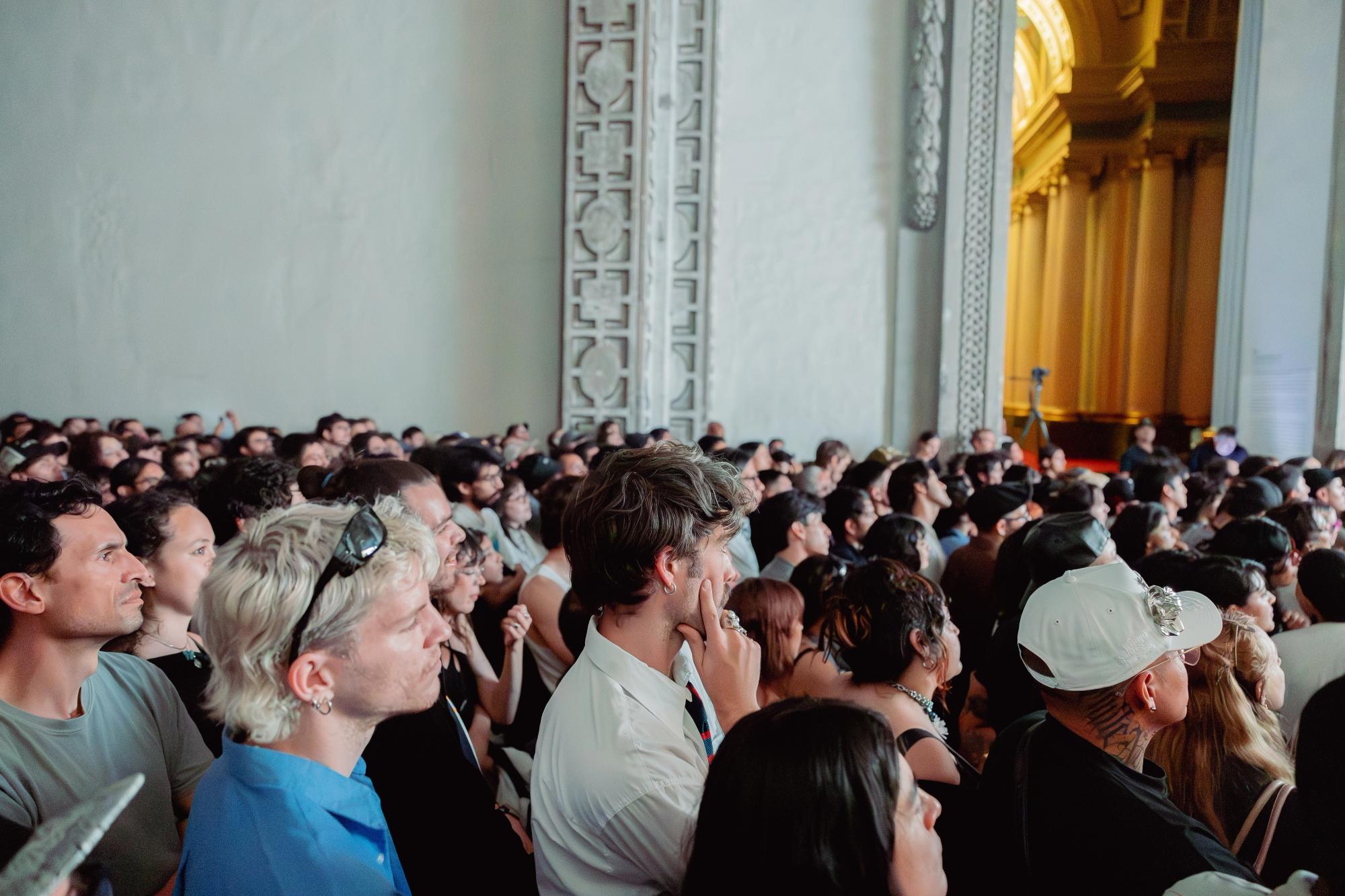
Eartheater & Freeka Tet at TONO Festival. Photo by Roy Freiha.
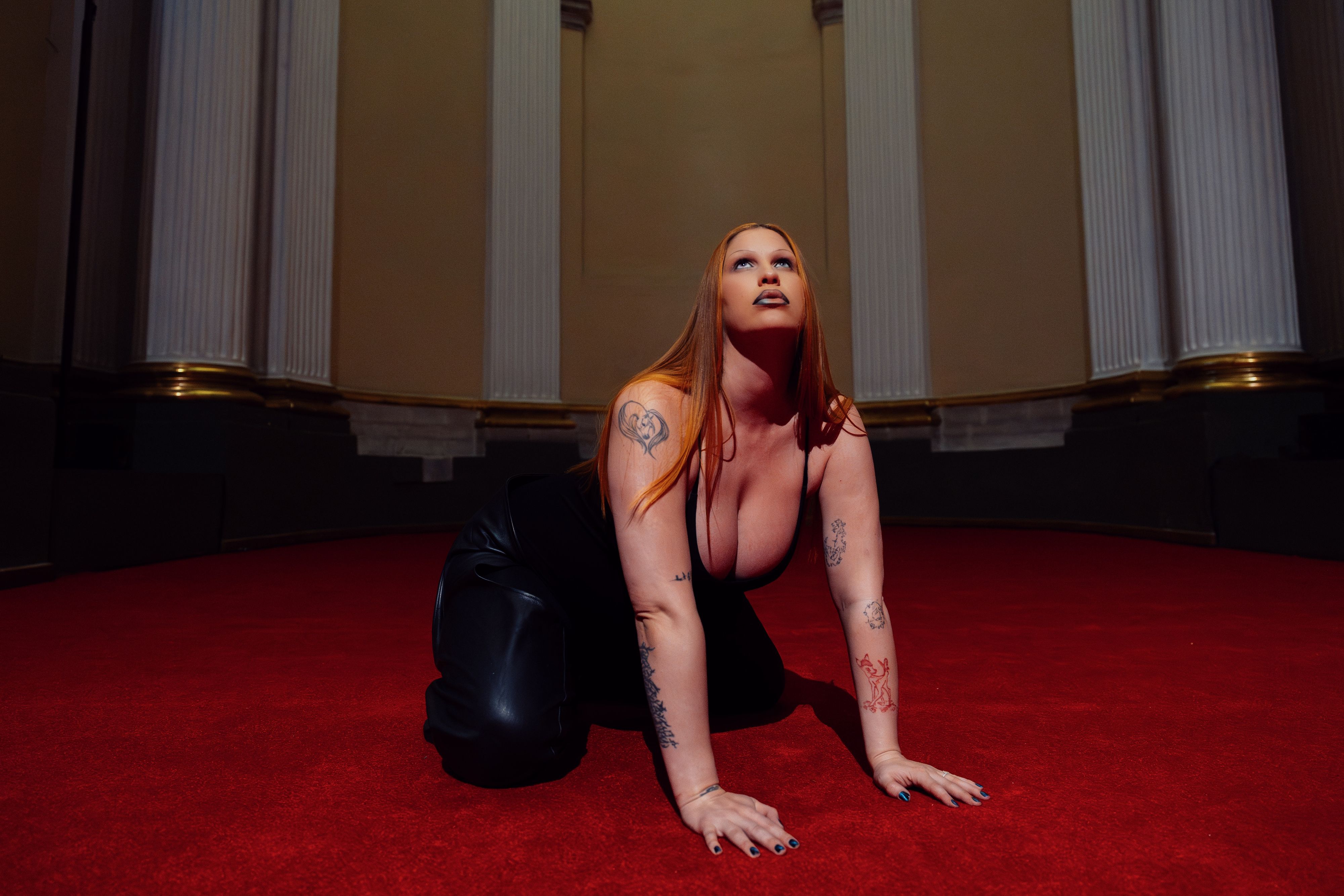
Eartheater. Photo by Roy Freiha.
When Eartheater’s Mexico City fans packed into Ex Teresa Arte Actual, a former 17th-century church-turned-museum in Mexico City’s historic center during the third edition of TONO Festival, they encountered a 20-foot LED screen in the central nave with a 5-minute countdown to an “Eartheater & Freeka Tet Livestream.” The display fueled rumors that the then heavily pregnant singer was not performing live. When the clock struck zero, the screen showed Eartheater in her house in rural Pennsylvania, accompanied by the musical duo Leya. The camera followed the trio as Eartheater sang a series of songs, moving from her living room to the porch, her voice getting breathier as she held her stomach, seemingly going into labor. The final shot was of her in a birthing pool in a bikini, crying out lyrics as she birthed a pink baby shark. Talk of the pregnancy spiraled throughout the room. Was it real? Did she already give birth? Was she in Mexico?
The screen cut to black and another 5-minute timer appeared, this time to Eartheater’s song “Live.” When the artist emerged from behind the screen, accompanied by local musician Estrella del Sol, it became clear that the “livestream” was actually a video performance timed for the release of Eartheater and Shygirl’s new song, “Shark Brain.” The video was directed by Freeka Tet, a digital artist, cultural mercenary, frequent collaborator of electronic music duo Amnesia Scanner, and director behind The Weeknd’s recent music video which featured the Brazilian popstar Anitta with an animatronic pregnant belly. Freeka also directed the live show, pairing the sound of the singer’s baby’s heartbeat with the image of a shark sonogram.
Afterwards, Sam Ozer, curator and director of TONO Festival, the global non-profit dedicated to time-based artwork, sat down with Eartheater (aka Alexandra Drewchin) and Freeka to discuss friendship as an artistic practice, Drewchin’s pregnancy, and blurring performance and reality. And now that Drewchin’s actually given birth, there’s no better time to reflect on performance as creation versus the art of the real thing.
Sam Ozer: Watching the performance was wild because in this beautiful way it’s almost a dress rehearsal for the actual birth. The introductory performance video was shot in your home, Alex, and during the performance we could hear the sound of your baby’s heartbeat from the ultrasound. What was the experience of shooting it versus performing it live?
Alex Drewchin: Being with everyone in this museum that used to be a church was lovely. It was just funny to act it out in the video, knowing that I’m actually going to have to give birth for real. A lot of people thought it was real, so I guess I must’ve done an okay job.
It was very convincing.
AD: Except my moans were in the melody of my song “Below the Clavicle,” which was Freeka’s idea. [Laughs.] I wonder if anyone caught that? I think the real fans probably noticed. It felt really awkward doing it, but I think it really came together well. I also loved the obfuscation that spiraled after the fact. After the performance, people were speculating on whether it was real or not. People were texting me saying that they had no idea I had a baby. It’s a good example of how information becomes so distorted on the internet. If you actually watch the video, you’d see that I give birth to a crude rendering of a hot pink baby shark. But because someone saw a couple of stills of me in a birthing pool in a bikini, it became, “Okay, yeah, you gave birth!” Then when the Nick Knight photos, which were my actual pregnancy reveal, came out, people completely switched and thought it was a bit. No one believed it. It was like I had cried wolf. But I love this kind of confusion. I like when things are a little bit mysterious. I don’t think anyone really needs to know exactly what’s happening.
SO: It’s the fine line between performance and reality. Freeka, was the countdown always the plan or did that idea come later in the creative process?
Freeka Tet: It came later. I thought it was a good way to tie everything together. At the beginning, it was a bit scary that Alex was pregnant for real. The idea that there could be an issue with her performing live became the core of the project. It was a constraint, but there was also power in it. We did the ‘livestream’ just in case Alex couldn’t come.
AD: The countdown was a very sweet moment for me because I was hiding behind the stage and unable to see the audience. I also couldn’t see the visual countdown, but at a certain point I could hear everyone and the excitement starting to swell in the room. And then the crowd started counting down — 10, 9, 8, etc. It was really adorable.
FT: It was like the New Year’s Eve countdown. It almost became a collective event.
AD: And pregnancy is the ultimate countdown. [Laughs.]
FT: Definitely. I’m sure you’re counting right now.
AD:I’m counting every second.
FT: I remember when I was in art school, one of the first books we read was TK by Paul Klee. In it, he describes drawing as a line taking a walk. I remember thinking that was really cool. It was like he was saying that art is making visible what is invisible for other people. I’ve always loved that, and I felt that this performance was just making visible a potential problem — a potential scheduling problem, a moment when real life gets in the way. To me, the idea of making something that relates to a very important time in Alex’s life that she can look back on is very cool. I’m more proud of that than anything else, if I’m being honest. The video was like a lifecycle at hyperspeed: an entire pregnancy and birth happens within minutes. But then because of the church and the all of the water involved, it almost felt like a baptism, which we haven’t discussed before. Did you think about that, Alex?
AD: I didn’t think about it, but I can see the correlation with a baptism. The whole thing seemed framed by that sort of divine space. That’s really where the video looks most beautiful to me. It’s not meant to be seen on the screen or on your phone. It would lose all its magic. Religion is filled with so much pageantry, which is why I refer to it a lot in my own work.
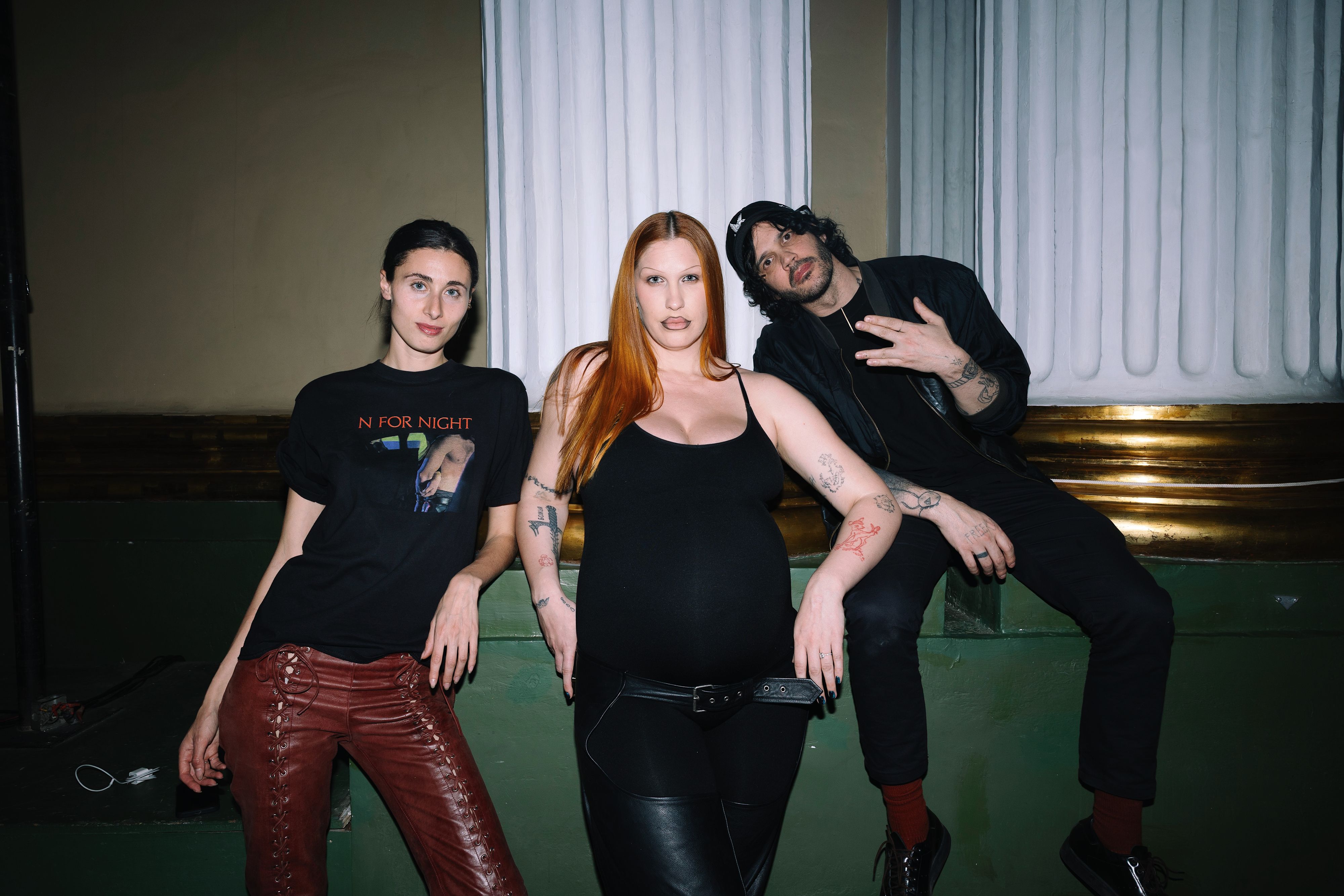
Samantha Ozer, Eartheater, and Freeka Tet. Photo by Roy Freiha.
I loved being backstage and seeing how the same type of inflatable pool used as the birthing pool in the video became the basis of Freeka’s light installation, which created a ripple effect on the back wall. There were a lot of meta elements folding in on themselves: filming the video at Alex’s house and then using elements of the video’s props in the IRL performance.
AD: It was really special. It’s kind of sad that the audience didn’t get to see the giant-pool-mirror contraption that we used to create all of those visuals. It was our little secret. It was also very religious — almost like an altar.
I loved how lo-fi so many of the designs backstage were. There was a light shining into this massive pool of water with a giant shattered mirror inside of it. It definitely wasn’t sleek, but from the audience’s perspective, it created the desired effect. Freeka, you had said there was something very honest about the video and the set-up. I also loved the sonogram imagery and sounds you put together.
FT: That was actually Alex.
AD: We decided to do that last minute. I loved playing to the rhythm of the heartbeat.
The image during the performance was of a shark sonogram but it was actually your baby’s heartbeat, right?
AD: Oh yeah. It was the shark’s sonogram. It wasn’t my real sonogram. I get confused at this point.
FT: Everything was mixed.
Shark baby and Alex baby.
AD: Yeah. Sharkira. [Laughs.]

Eartheater. Photo by Roy Freiha.

Eartheater & Freeka Tet at TONO Festival. Photo by Roy Freiha.
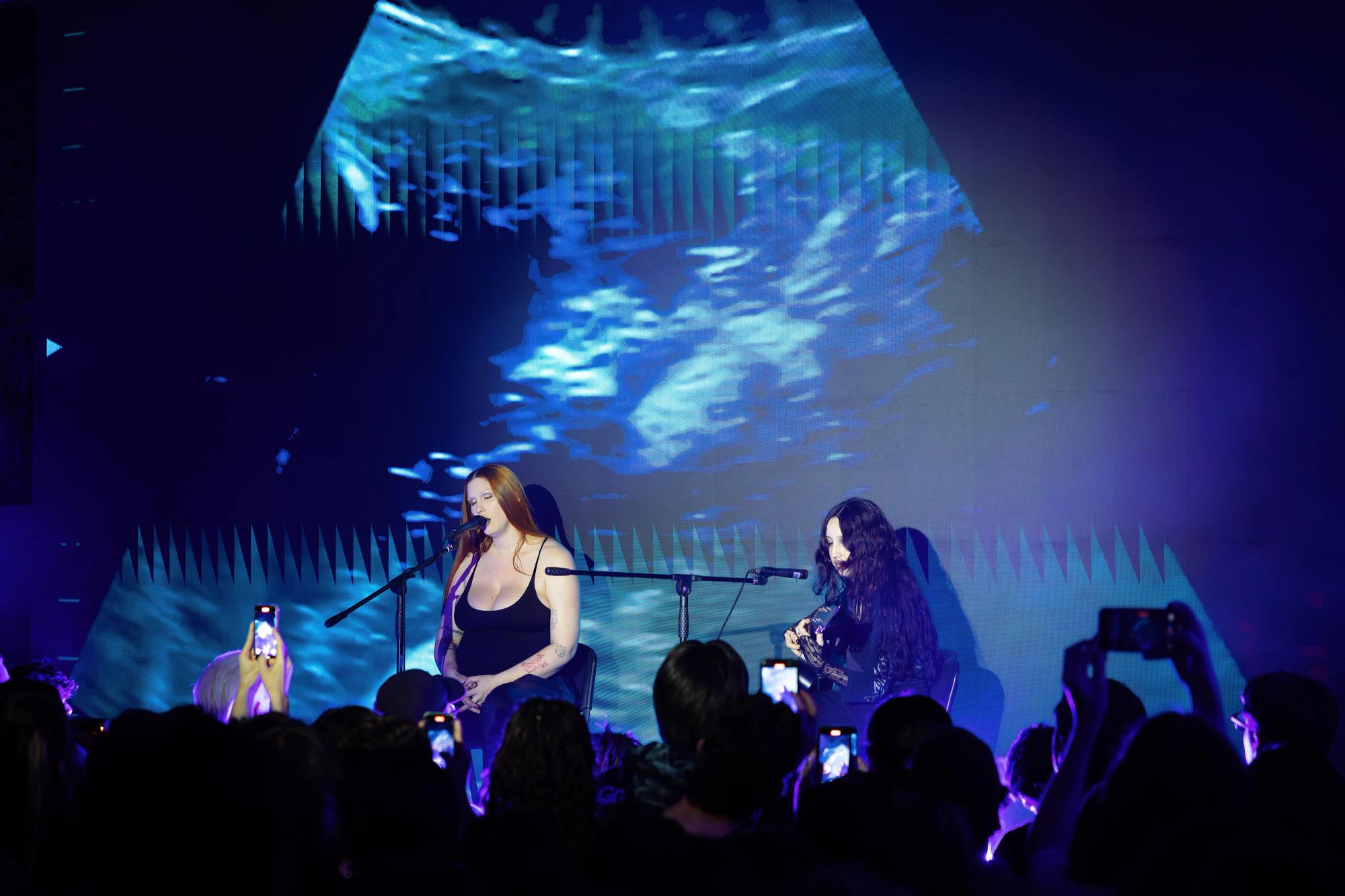
Photo by Roy Freiha.
What was it like collaborating together for the first time?
AD: We made something together before but haven’t shown it to the world yet.
FT: We’ve worked on our friendship.
AD: Our friendship is our main art project. But this project was really special because typically, I can be very controlling. But with this project, I embraced relaxing into it. That in itself is a metaphor for labor and where I’m heading in this part of my life. [Raising a child] takes a village, you know. It requires collaboration. I will need to work with the village, with my friends and family. There were times when I was very clear about what I did and didn’t want, but a lot of the time, I felt so relieved to just be a human medium for Freeka’s vision.
FT: I feel exactly the same way. This work for me was also very different from what I usually do. We both stepped out of our comfort zone and what we created was something that was completely unique for the both of us.
AD: Freeka, I thought it was really cool that you were quite adamant in the beginning that you wanted the music to be acoustic. I was suggesting all kinds of different electronic soundscape ideas and you were like, “No, no, no. I really feel like it needs to be acoustic.” That really tickled me. I loved that.
FT: I love your range, and I felt like the softness just worked for this. We could have dropped crazy kick drum, full-on club stuff, but I don’t think it was the right mood.
AD: In your direction, Freeka, I love that you kept it very raw. If you look at my album covers or my videos, generally they’re very fantastical and otherworldly, and I’m always really stylizing everything. Stripping it back was a new exercise for me. When I think back to the speculation as to whether or not I was pregnant, what’s interesting to me is that the art that was the rawest — this video — was perceived as reality. And then when I did a very stylized, retouched, and glossy shoot with Nick Knight, it seemed like it was fiction. Meanwhile, that was my reality.
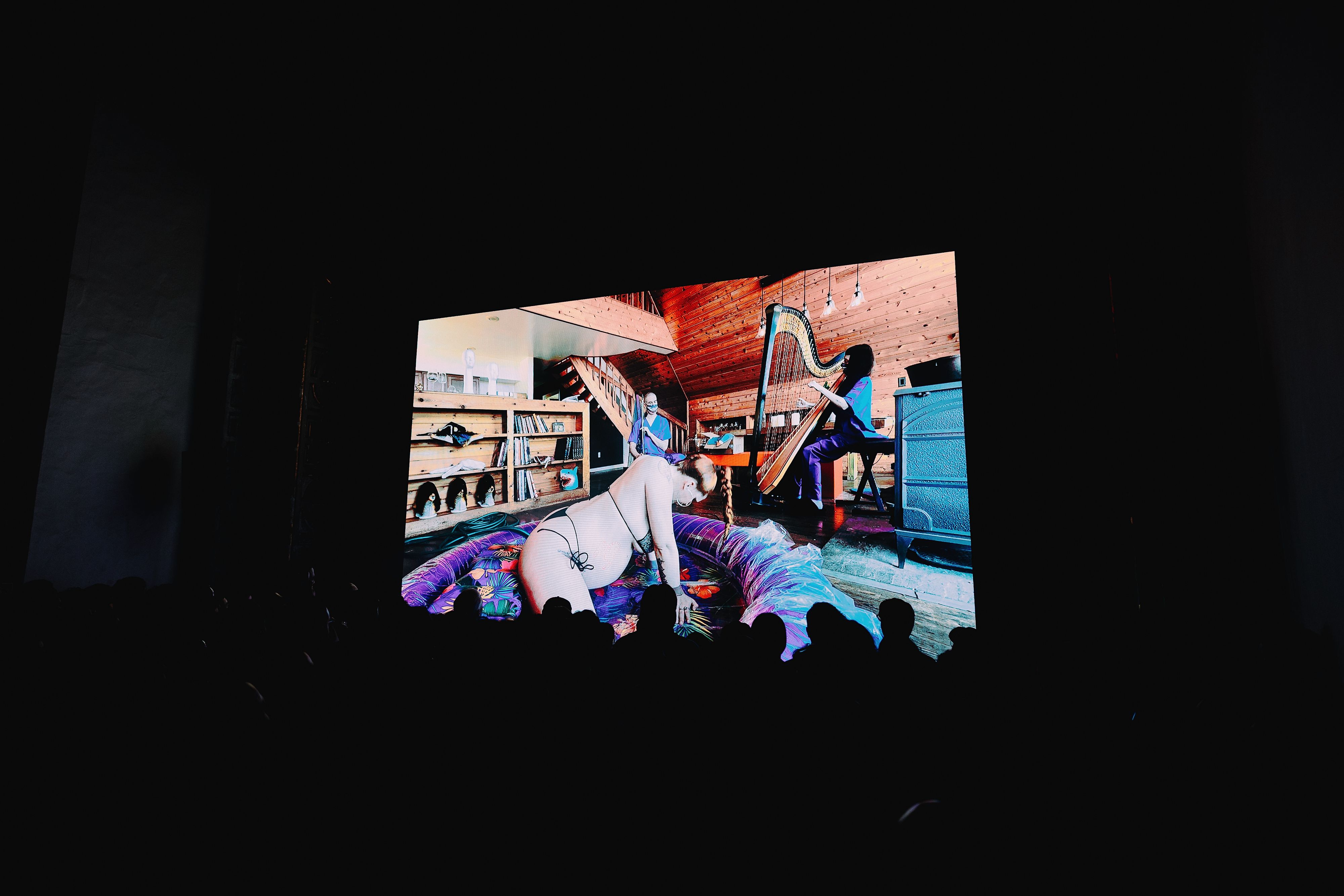
Eartheater and Leya in the Eartheater & Freeka Tet Livestream at TONO Festival. Photo by Roy Freiha.
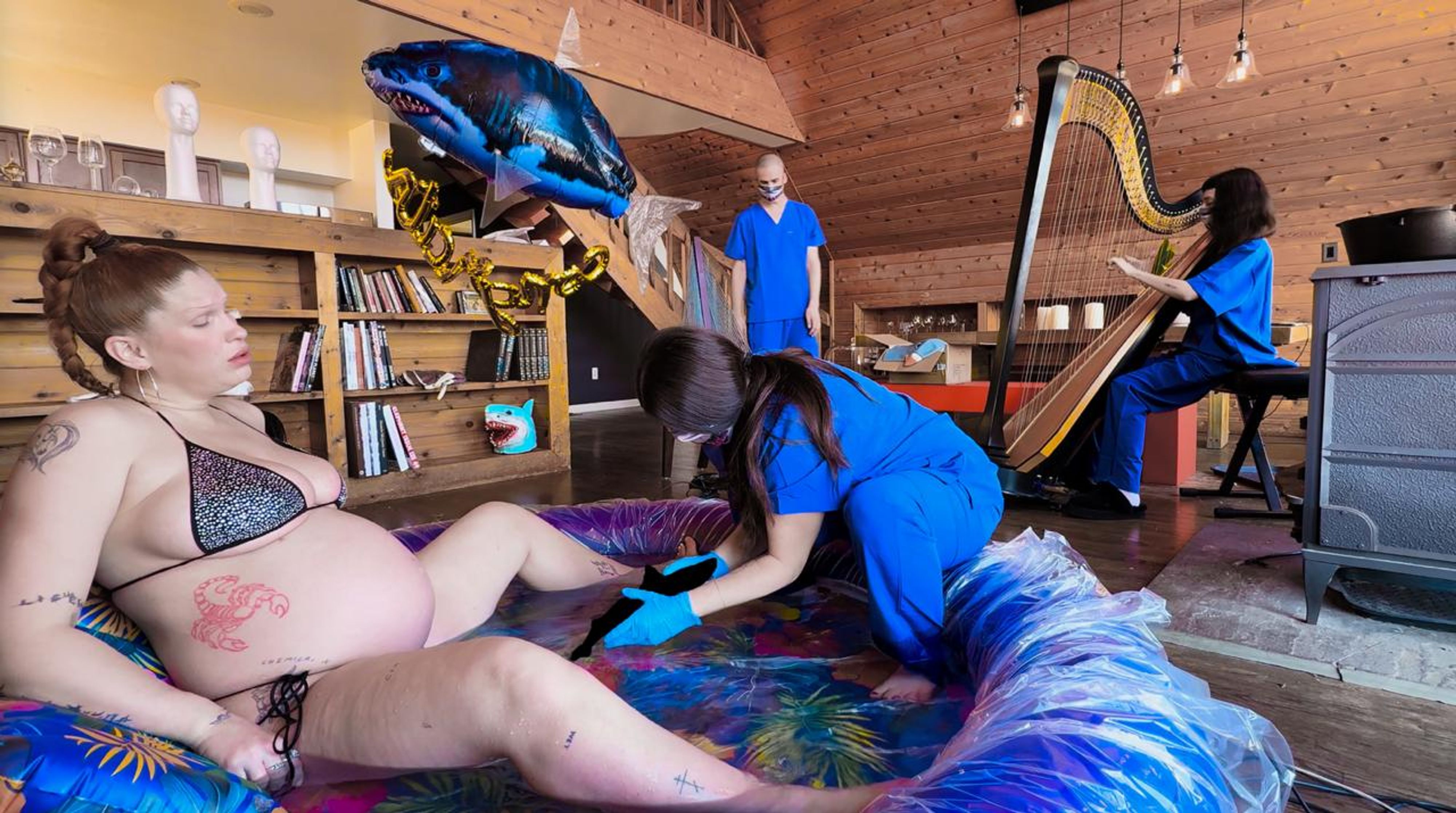
Eartheater (aka Alexandra Drewchin) filming the baby shark birth. Photo courtesy of TONO Festival.
In the end, though, Freeka, you edited the animatronic shark that you painted out of the final cut. That was interesting because throughout the process, you would send me check-ins and ideas on how to create this shark, but then you created a shadow — a kind of negative of it — instead.
FT: For me, sometimes the absence of the thing is the best way to make it relevant. When I see the cut-out, I see the shark even more because then it’s just about the movement. I couldn’t have competed with that beautiful shark Nick Knight had. [Laughs.]
AD: I’m glad that we embraced going in the complete opposite direction. That was how the project started: with Freeka sending us videos of various animatronic shark ideas or renders of different shark technologies. [Laughs.] I like where we ended up. I think it’s a testament to our confidence together as friends. We ended up freezing a moment of my pregnancy, which was part of the concept but also something we both agreed was best, to keep things stress free and easy.
FT: I think that’s a really big point you’re making. When you’re in a room with a pregnant woman, you want things to be stress free...
AD: I’m going to keep a prosthetic belly around. [Laughs.]

Eartheater and Leya for the Eartheater & Freeka Tet Livestream at TONO Festival.